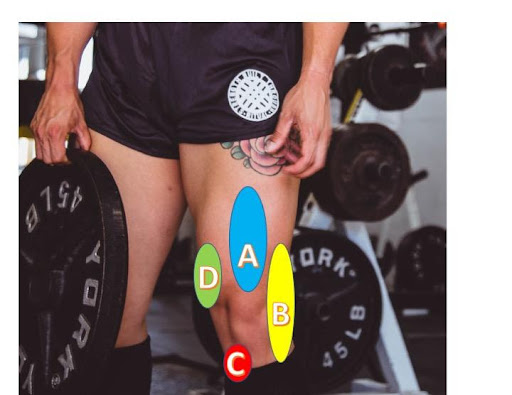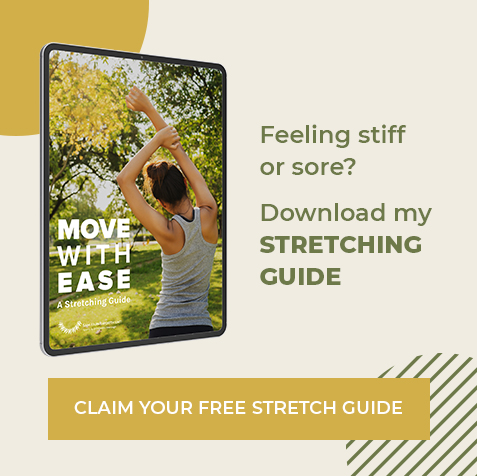Knee pain can come in many flavors. While there is acute pain caused by a catastrophic injury to a ligament, bone fracture or meniscus/labral tear, this article will focus on chronic aches and pain. Many pains are associated with muscle, tendons and the IT Band. And guess what, they don’t show up on imaging and are hard for orthopedists to address.

The image at the right shows four common areas – above the knee cap, outside of the knee, inside and below the knee cap to the inside of knee. There are nine muscles that connect around the knee on the front (anterior) or inside (medial) of the knee. If any one of these are hypertonic, soreness is felt in the region of the knee.
I can work with you to determine which muscles are tight and how you can address these at home. The following is a somewhat technical discussion of general patterns I have observed with some basic tips for addressing these areas. I am going to use the proper names for the muscles involved, check the second figure for an anatomical locations.
A – Above knee cap – the muscle most often involved is the rectus femoris which runs right up the middle of your quads. But it can also involve the deeper vastus intermedius which sits under the rectus femoris. Work for these muscles would focus on the anterior superior iliac spine (ASIS), the patellar tendon and trigger points for each muscle. Tightness here is often seen in walkers and bikers.

B – Outside knee and up the side of the thigh. Pain in this region is often identified with the IT band. And that may be so, but I have observed the muscles on each side of the IT band holding tension. The first muscle is part of the quads – the vastus lateralis, and the second is our biggest hamstring – biceps femoris. There can be pain on the side of the knee that wraps around the back of the biceps femoris and may extend farther down the leg. A comprehensive solution addresses both of these muscles and the glute medius and glute maximus which can tension the IT band. Often seen in runners and bikers.
C1 – Inside below knee – Pain in this area can be intense and can affect your gait. The culprits here originate from an attachment point below the inside of your knee (where it hurts). The muscles are the sartorius, gracilis and semitendinosus. The sartorius wraps around your thigh and can become tight if you cross your legs frequently. Gracilis is a strong muscle which goes right up the inside of your thigh to the groin area and can cause groin pain. Finally, the semitendinosus is one of your hamstrings. Again, to relieve pain from this area requires a comprehensive approach checking the attachments for each of these muscles as well as all other thigh muscles. These adductor issues can come from a slight change in gait or compensation from other tight muscles, thereby resulting from many different activities.
C2 – Inside behind knee pain – Adductor longus causes pain on the inside of the thigh, right behind the bones of the knee. This muscle attaches to the back of your femur (thigh bone) and runs up into your groin. Techniques for addressing this area are straight forward, but may require multiple sessions to achieve a complete resolution. The adductor muscles tend to be tighter on anyone and require more care when treating.
D – Inside at/above knee pain – A tight vastus medialis or VMO can cause pain in this area. The sartorius or adductor longus can sometimes also be involved creating pain in the bone behind the knee. However, VMO treatment is straight forward. A tight VMO can often be seen in bikers.
Finally, a word about “Runner’s Knee”. Runner’s knee can be caused by strength imbalances across the quadriceps muscles. The imbalance can result in knee cap (patella) tracking issues, which creates pain across the knee cap. The solution requires strengthening the weaker muscles (often the VMO muscle located on the inside of the thigh) while relaxing and lengthening the vastus lateralis located on the outside of the quad.
The good news? With my detailed knowledge of anatomy, symptoms and the targeted treatment and stretching tools these issues can be addressed in a straight-forward manner.

